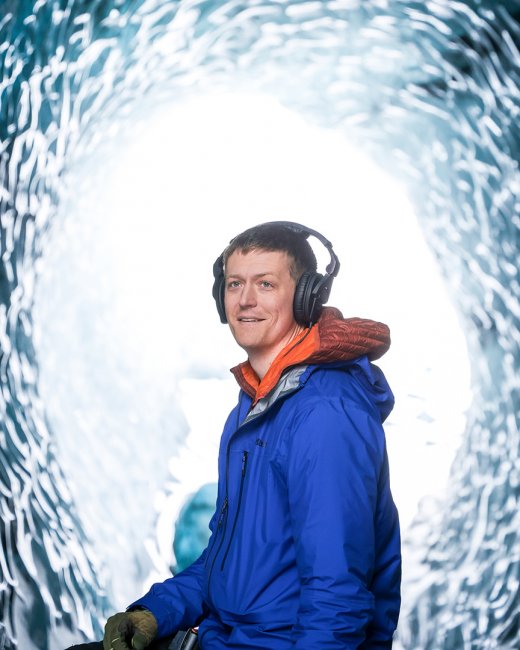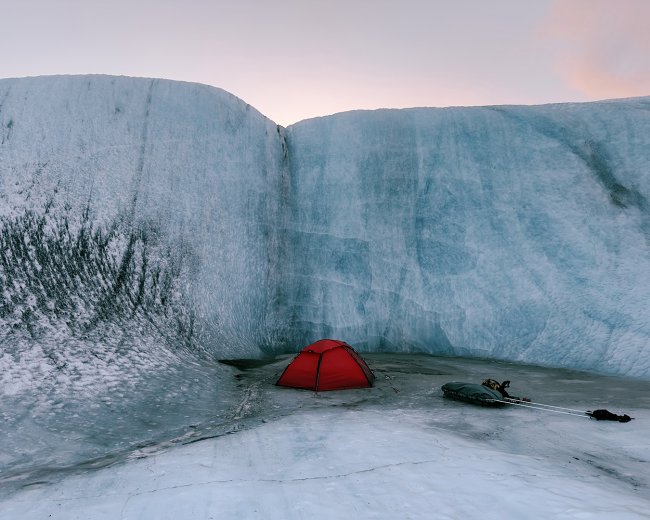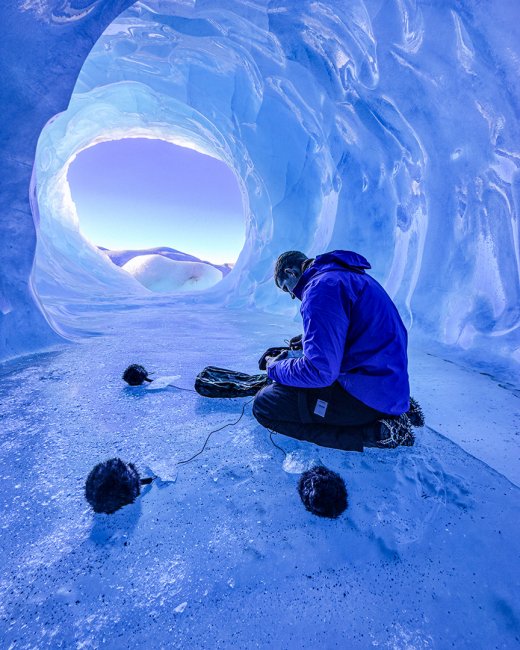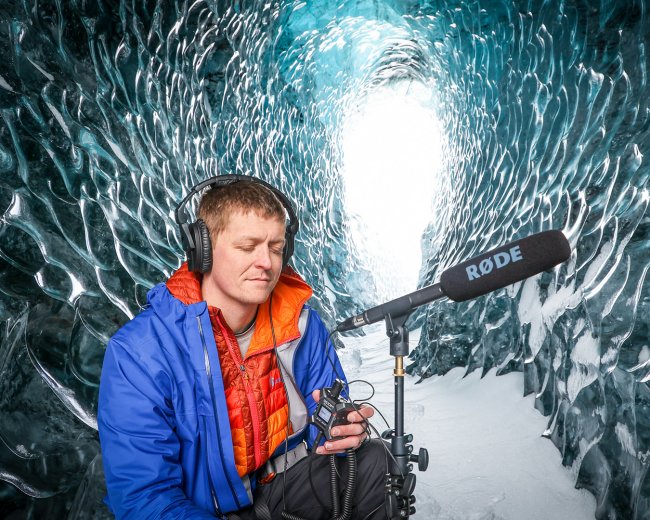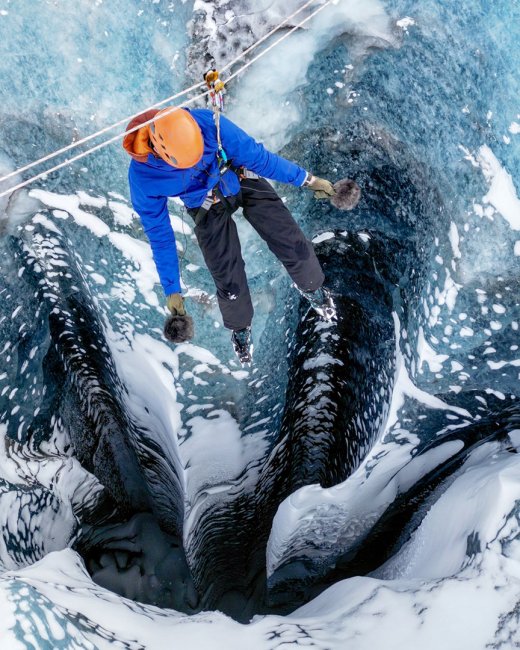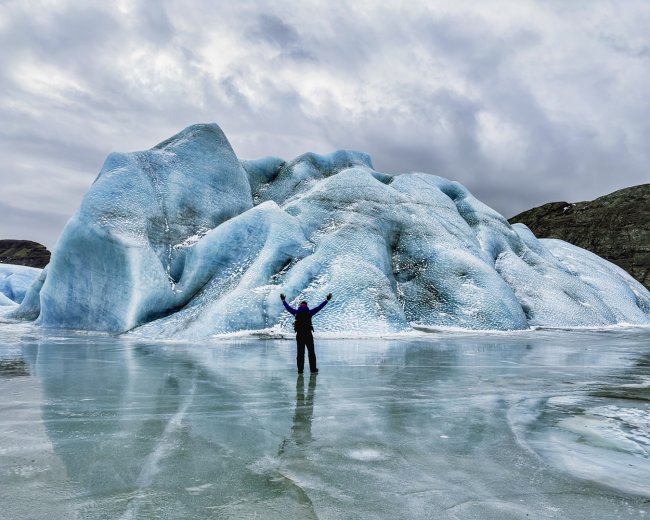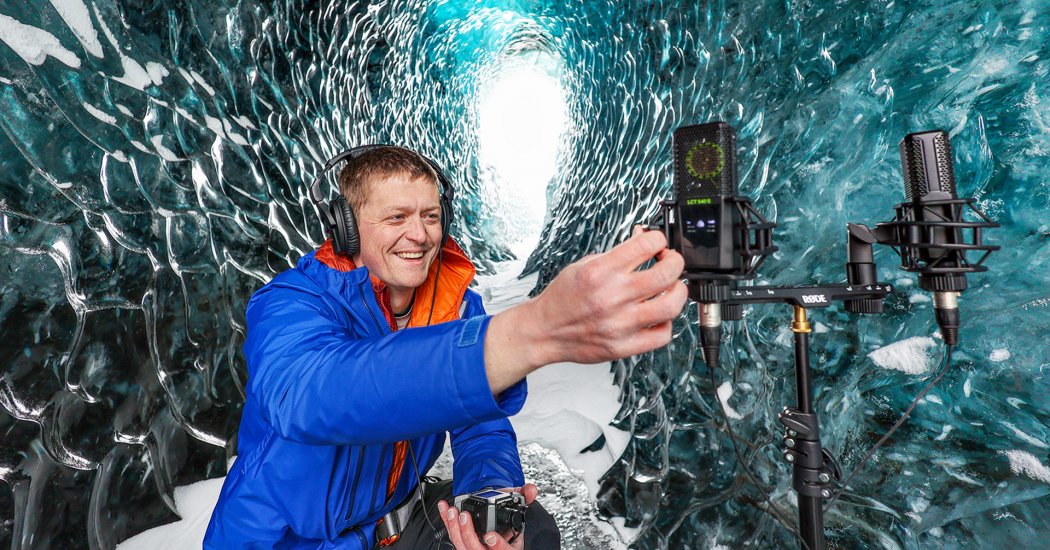
How far would you go to get amazing sound samples? Well, if you’re Thomas Rex Beverly, then the answer to that question spans continents. This adventurous recording engineer has recorded the most elusive sounds in the world in some of the most difficult-to-reach locations. Recently, Beverly traveled to Greenland and Iceland, where he recorded the ethereal calving sounds of disappearing glaciers. In this article, we’ll journey to the ends of the earth with Beverly and discuss how he captures otherworldly soundscapes and transforms them into his incredible sound libraries, which have been used by Oscar and Emmy Award–winning artists and filmmakers in a whole host of high-profile film and television projects, including CODA, Ant-Man and the Wasp: Quantumania, Yellowstone, The Last of Us, Tom Clancy’s Jack Ryan, Star Trek: Picard, and Frozen II.
- Finding the Correct Path
- The World’s Largest Recording Studio
- Preparing the Body
- Getting the Whole Picture
- Choosing the Right Location
- Destination: Greenland
- Chasing the Thunder
- Exploring the Depths
- Capturing the Dragon
- Trekking to Iceland
- Pursuing the Wind
- The Melodies of Nature
- Putting It All Together
- The Journey Has Only Begun
- Sweetwater Is Here to Support You
Finding the Correct Path
According to Thomas Rex Beverly, he didn’t originally set out to become a mountain-climbing, spelunking sound recordist. Rather, he started out as a composer. “I went to college for musical composition,” he says. “I wrote a lot of contemporary classical music.” In fact, Beverly was on track to obtain a doctorate and become a college professor. But fate apparently had other plans. “Academia was not for me,” he muses. “Instead, I branched out into nature sound recording, mostly for films and video games.”
Beverly honed his engineering chops while working toward his master’s degree. “I learned a lot about music technology and audio engineering,” he recalls. “That taught me the nuts and bolts for both studio recording and running live sound.” But, as time went on, he began exploring the great outdoors. “I started taking the microphones at my university outside,” he states. “I began creating multimedia sound art using video, field recordings, and live instruments.”
Eventually, Beverly realized his attention was shifting away from his music composition studies and toward field recording, which gradually became his main focus. “For the last eight years or so, I’ve been doing full-time field recording,” he explains. “I spend a lot of time going on big adventures.”
The World’s Largest Recording Studio
Beverly has recorded nature sounds as diverse as grizzly bears, hummingbirds, thunderstorms, avalanches, ice lasers, and calving glaciers, so you could say he works in the world’s largest recording studio: the entire planet earth. But, unlike engineering in a typical recording studio, field recording requires you to possess a working knowledge of topics far outside the typical realms of pro audio.
“I learn a lot about the geography and biology of the places I’m recording in,” Beverly explains. “If I’m focused on recording a specific animal, I’ll learn a bunch about that species as well as about their ecosystem.” He explains that he needs to learn the animal’s habits, such as where it nests. “I need to be able to get close enough to record the sounds but without disturbing the animal,” he states.
In order to effectively capture the sounds he’s chasing, Beverly has gained extensive knowledge about everything from animals to weather to glaciers. “To record glaciers, I needed to figure out how glaciers work, when they move, and what season I will need to work in,” he explains. He also frequently employs mountaineering guides who help him navigate extreme environments safely. “I can do some pretty wild stuff,” he explains. “I need a local expert to take me out and keep me safe, so I know I’m prepared.”
Preparing the Body
Recording sounds in the natural world is definitely more physically demanding than normal studio sessions. Hence, Beverly has had to maintain a higher level of fitness than your typical studio rat. “I do a lot of backpacking,” he explains. “I put a 45-pound steel plate in a rucksack and go for a 10-mile hike — it’s the best way to train for hiking while hauling 45 to 60 pounds of audio gear into the backcountry.”
Beverly adds that besides his audio gear — a recorder, microphones, cables, and batteries — he also has to carry his outdoor gear, just like anybody else who is backpacking. He also has to physically prepare for specific scenarios. “You need to train for different types of trips,” he advises. “For example, if I’m going to be ice climbing, I need to get my arms in shape.”
Getting the Whole Picture
During a typical trip, Beverly will frequently run as many as six or even eight recording rigs. “I put all those drop rigs in different places, so they can cover a very wide space,” he explains. “I try to get as many different perspectives as possible because different things will happen in different areas.” According to Beverly, capturing different perspectives may require him to point acoustic microphones at various sound sources, place hydrophones underwater, attach contact mics to a piece of wood or ice, and more. “I often find sounds that I never knew existed while experimenting with nontraditional recording techniques,” he muses.
“Sometimes, I’m focused on trying to capture the sounds of a specific bird, like a hummingbird or loon,” Beverly continues. “I need to set up a mic near a nesting area.” Beverly will frequently need to leave microphones out by themselves for over 24 hours to capture wildlife in their natural habitats. “Some wildlife will behave very differently if you’re sitting there,” he emphasizes. “Of course, there are situations where it’s not actually safe to sit there for long periods of time; a grizzly bear could sneak up on you.”
Choosing the Right Location
When Beverly decides on a recording location, it’s not accidental — there’s always a method to his proverbial madness. “Sometimes, I get a commission from a film or video game where they’ll hire me to record specific sounds exclusively for that production,” he advises. “They’ll tell me what they need, such as sounds from a temperate rainforest or desert.”
When choosing where to record, it’s important that the sounds he records match the location of the production. “If the film or game takes place in Alaska, you don’t want to have birds native to Germany chirping in the background,” he explains. “You’ve got to ensure that you’re capturing wildlife from the right location, or the birders will call you out on X.”
Beverly notes that some of his work isn’t the result of a direct commission; rather, he simply scouts locations that he finds appealing. “I try to find interesting places that I want to go to so that I can also record enough sounds to make libraries I can sell to sound editors and sound designers,” he explains. “I’m gradually trying to build a diverse catalog of nature sounds from different kinds of locations, and I’m trying to branch out into different continents; right now, I’m most interested in polar environments, but I’m also interested in exploring South America and New Zealand on my next few expeditions.”
Destination: Greenland
When asked why he set out to record glaciers in Greenland, Beverly explains that it wasn’t a spur-of-the-moment idea. “I’d seen a glacier on a big trip to Alaska in 2019, but I didn’t actually get close to it,” he recalls. “I’ve gradually become more and more interested in glaciers over the past few years.”
“I noticed that there’s a lot of emphasis put on photography and videography, like documenting retreating glaciers with time-lapse photography, but I began to wonder what they sounded like,” he continues. “It seemed obvious that they’re going to make big thunderous sounds as the iceberg calves off the front, but most of the videos I’d seen had underwhelming audio captured with the camera — I wanted to capture those sounds in full fidelity and share them with others.”
Chasing the Thunder
To fully capture the thunderous sound of calving glaciers, Beverly employs an array of tried-and-true gear. For starters, his Zoom F3 and Zoom F6 field recorders see a lot of action, thanks to the expansive dynamic range of their 32-bit analog-to-digital conversion. “Much of the stuff I’m recording is ridiculously loud, but there’s also really delicate, soft details,” he explains. “That’s why 32-bit float recording is so fabulous — it captures the full dynamic range.” He also uses the Sound Devices Mix-Pre-3 II and Sound Devices MixPre-6 II audio recorders.
Beverly also utilizes a number of Sennheiser products for his field-recording endeavors, including his trusty Sennheiser HD 280 Pro headphones. “I’ve used the Sennheisers for a long time,” he says. “They offer a flat frequency response, and they hold up in extreme environments.” He also employs Sennheiser microphones, including a selection of Sennheiser MKH 8020, Sennheiser MKH 30, and Sennheiser MKH 8040 microphones. “Sennheiser 8000-series microphones perform flawlessly in extreme temperatures and high-humidity environments,” he advises. “They are my go-to microphones on recording expeditions.”
Beverly’s main recording rig includes a double mid-side setup using the MKH 30 and two MKH 8040s. “I have a front and rear mic, which, in my case, is a pair of 8040s, and the side mic is an MKH 30,” he explains. “It can capture everything from close-up to recording surround sound, and it’s lightweight and compact, which is better on my back.”
Beverly also deploys an ORTF surround rig of four Lewitt LCT 540 S cardioid microphones, along with LOM Uši and DPA 4060 omni microphones, RODE NTG-2 and Sennheiser MKH 416 shotgun microphones, and a couple of Crown PZM 30D pressure zone microphones.
Exploring the Depths
Beverly employs hydrophones, many of which are DIY designs made by a retired Navy Submariner, for underwater recording, which are deployed in frozen conditions by drilling holes in the ice. “I drill a hole and stick a hydrophone through, and I repeat the process with them spaced out at least 10 feet apart,” he states. “Because of the density of the water, you have to space the mics out farther to get a good stereo image.”
It’s also important to remember that sound waves travel through the water much faster than they do through the air — something that became extremely apparent to Beverly while he was recording using a stereo pair of hydrophones in tandem with a stereo pair of omnidirectional small-diaphragm condenser microphones. “I was monitoring the two channels of the hydrophones in the water,” he recalls. “I heard a loud calving boom come through the headphones, which made me yell,” he continues. “I was upset because I thought I ruined the recording by shouting, but because sound travels faster through water than through air, the above-water boom arrived after my yell, which meant that it didn’t spoil the recording.”
Capturing the Dragon
According to Beverly, some of the most captivating sounds he captured in Greenland took place under the ice. “There are a bunch of sounds that happen inside the glacier,” he explains. “If you get out on it, you can hang microphones way down in the deep crevasses and capture resonant water sounds.”
“You get a sound running through what’s essentially a big, icy cathedral down in the glacier,” Beverly continues. “It creates really ominous drones; it’s a low pitch and a couple of harmonics above it. Sometimes, there’s even resonant crackling and popping like some sort of alien language deep in the crevasses.”
Beverly recalls hearing a low-frequency sound that was emitting earthquake-like vibrations. “I got a bit worried when I heard that,” he recalls. “I thought that maybe we should have gotten out of there, but my guide assured me that it was okay, so we wandered around until we found the source of it.”
Beverly discovered that the sound, which he calls “dragon’s breath,” was being caused by a waterfall inside the glacier that was creating massive air bubbles. “The bubbles would burst, and the sounds would resonate through the crevasse,” he explains. “But it only happened for 20 minutes; I set up a rig to record overnight, but it only did it for 20 minutes — I just happened to be there to hear this fleetingly beautiful moment. Then it was gone.”
To capture this sound, Beverly employed Sennheiser MKH 8020s, along with LOM Geofóns, which are a type of contact microphone, that he was able to affix directly onto the glacier.
Trekking to Iceland
After Beverly returned from Greenland, he knew he still had much more exploring to do, and he set his sights on a winter expedition to Iceland. “Greenland was my first big trip exploring glaciers,” he explains. “That was in the summer, and I was curious what was going to happen in the winter — I also wanted to explore more around glaciers.”
Beverly notes that the glaciers in Iceland are disappearing rapidly. “Overall, Icelandic glaciers are just like the ones in Greenland — they are taking one step forward and two steps back. So, they retreat deeper into the fjord each year but also lurch forward in spurts. This forward movement creates immense pressure on the frozen lagoon, and it causes the lake ice to move in a way that it normally wouldn’t,” he explains.
“I’ve been trying to record moving lake ice for several years, but it’s really difficult,” Beverly states. “The ice has to have the right thickness, and you can’t have snow on top of the ice.” He explains that having snow on top of the ice not only dampens the sounds he’s trying to capture but also makes it difficult to see where he’s walking, which can be dangerous.
Iceland during the winter turned out to be perfect for capturing moving ice. “There was a predictable cycle where everything would thaw during the day and refreeze at night,” he explains. “And I was getting excellent ice movement during the refreezing.”
“I got exactly what I’d hoped for,” Beverly continues. “The ice was cracking and booming and making sci-fi laser sounds — ice lasers — because of the immense pressure from the glacier, and it was making pops, fizzles, and cracks as it was melting.”
Pursuing the Wind
Beverly recalls that he spent his first week in Iceland trying to record wind sounds. “I was focusing on trying to record ominous wind drones,” he recalls.
“I was referred by some locals to a couple big mountain passes with gigantic power lines that go up through them,” he continues. “Add 60-mile-an-hour winds to that, and you get some ridiculous melodic tones.”
“Lots of crazy stuff happens during 80- or 90-mile-an-hour winds,” Beverly states. “Whether it’s an old barn groaning or just wires and fencing rattling and whistling, it creates an interesting character. Imagine what a wire running half a mile from a valley up into a mountain pass sounds like — it resonates slowly and ends up with a singing drone that changes pitch depending on the speed of the wind.”
The Melodies of Nature
Beverly also discovered a fascinatingly melodic natural phenomenon. “The front of one of the glaciers had a glacial lagoon that was completely frozen,” he explains. “Then there were these big boulders at the edge of the lake; when the boulder heats up in the sun, the ice around it melts, and you end up with giant ice flakes.”
“The flakes are around a half-inch thick and around 10 by 10 feet, and they’re elevated around the boulder,” he continues. “If you tap on the ice, it sounds like a marimba.”
“It has a really beautiful, melodic sound,” he continues. “Different-sized flakes produce different pitches, so you can hit it in different spots and bring out other notes.”
Putting It All Together
Beverly frequently runs multiple recording rigs in order to capture everything that’s happening in both stereo and multichannel audio formats and sometimes records video. And given that he’s often recording 24 — or more — hours at a time, for weeks at a time, that produces a lot of data, which he stores on Samsung and SanDisk Professional solid-state drives. “I often come back with three or four terabytes of audio,” he advises. “It generally takes me three days of editing for one field recording.” As such, his studio gear and workflow are very important to his success.
Beverly bases his studio rig around an M1 Max–based MacBook Pro running Apple Logic Pro, Apple Final Cut Pro, iZotope RX 10 Advanced, Soundminer, and Cockos REAPER. He employs Focusrite Scarlett audio interfaces, Genelec 8010A studio monitors, and a Genelec 7040A subwoofer.
The Journey Has Only Begun
Even after such a grueling adventure, Beverly is still hungry for more. “I’m looking forward to more expeditions in the future,” he advises. “I love polar regions, so I’d love to create more glacier recordings in the future in Svalbard, New Zealand, and maybe even Antarctica.”
Sweetwater Is Here to Support You
Thomas Rex Beverly is a longtime Sweetwater customer. “I started buying gear from Sweetwater when I was doing a master’s program at Bowling Green State University,” he says. “I came to the store a few times, and I’ve been buying gear from y’all ever since.”
Beverly notes that he thought of Sweetwater when it came time to prepare for his Iceland expedition. “Between hiring tour guides and travel costs, I’ve been working with manufacturers like Sennheiser to help finance everything,” he explains. “I made a pitch to Sweetwater to see if you could help support the trip, and you came up with a bunch of gear, including new microphones, recorders, some SSDs, and audio accessories.”
Glacial Ambitions? Sweetwater Can Help!
No matter what you’re trying to record, whether on land, under the sea, or in glacial fjords, Sweetwater can help you put together the right recording and editing rig. Our Sweetwater Sales Engineers are experts here to assist, whether you’re recording music, voice, wild animals, ice caves, or wind. Call us at (800) 222-4700, and we’ll put together a package of everything you need to succeed — no matter where in the world you are headed.
To learn more about Thomas Rex Beverly’s work, check out his website: https://thomasrexbeverly.com/


